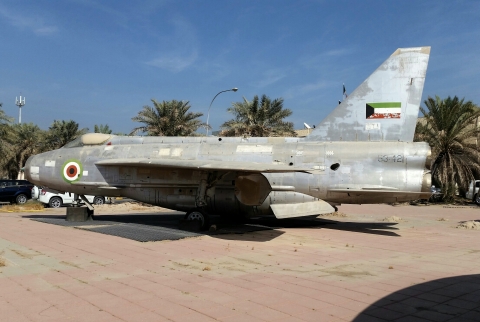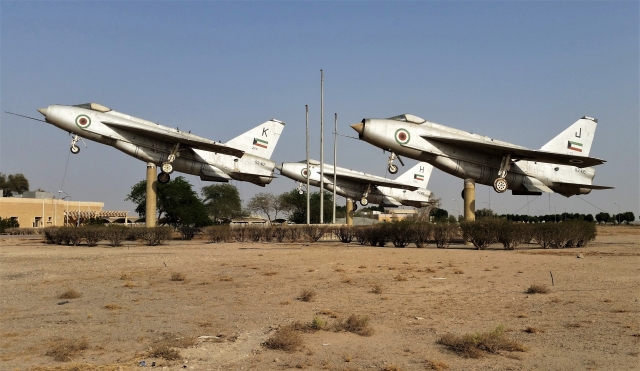10 minute reading about the BAC Lightning in Kuwait Air Force service. Scramble Magazine exclusive!
It is a little bit chilly on Wednesday 4 December 1974 as Lightning F53 with serial number 53-418 together with wingman 53-416 from the Kuwait Air Force (KAF) leave the tarmac to take-off from an airbase near Kuwait City towards the Udairi shooting range to conduct a two-ship SNEB* (Air-to-ground rocket) mission. At this December day it had been more than five years since 53-418 was exhibited by the British Aircraft Corporation (BAC) during the 1969 Paris Air Show at Le Bourget with showcode 512.
Besides neighbouring country Saudi Arabia, Kuwait was the only export customer for the British Lightning mach-2+ all-weather jetfighter. English Electric (EE), who originally developed and manufactured the Lightning, was later absorbed into the BAC-consortium. A total of fourteen export Multi-Mission Lightnings were acquired by the KAF divided between twelve F53 single-seat and two T55 dual-seat aircraft. All were built and test flown at the BAC Samlesbury plant. Unofficially, the Lightnings in KAF service were designated F53K and T55K.
The export Multi-Mission Lightning F53 was based on the RAF's Lightning F6 interceptor aircraft. The main difference was that the F53 could be quickly interchanging between interception, reconnaissance, and ground-attack tasks. One unique venture of the F53 was that the Lightning characteristic overwing fuel tanks could be replaced by Matra JL-100 combined rocket- and fuel pods, each containing 18 SNEB 68mm rockets and 227 litres of fuel.
At the end of their operational life in 1976 the KAF Lightning fleet had amassed a total of 3,133 flying hours. With the first aircraft delivered to the mainland of Kuwait in December 1968, the Lightning Squadron becoming fully operational capable during 1969.
 The Lightnings did not achieve that many hours during their seven and half years in KAF service. Although being proud of their Lightnings, it is understood that the overall serviceability of the Lightning was poor because the Kuwaiti's thought too easily about maintaining and servicing such a complex aircraft. Already during 1973 the Lightnings were offered for sale but no buyer was found. All residual Lightnings were eventually placed in storage during 1976 and 1977 at Al Mubarak/ Nawaf Ahmad air base, a part of Kuwait International Airport.
The Lightnings did not achieve that many hours during their seven and half years in KAF service. Although being proud of their Lightnings, it is understood that the overall serviceability of the Lightning was poor because the Kuwaiti's thought too easily about maintaining and servicing such a complex aircraft. Already during 1973 the Lightnings were offered for sale but no buyer was found. All residual Lightnings were eventually placed in storage during 1976 and 1977 at Al Mubarak/ Nawaf Ahmad air base, a part of Kuwait International Airport.
Nowadays a total of ten former KAF Lightnings can be found in pretty good shape throughout Kuwait. The KAF lost three Lightnings whilst in service during the seventies. Although being damaged during the 1991 coalition bombing campaign, whilst Iraq occupied Kuwait, most of Lightning T55 55-410 is still extant at Ali Al Salem air base.
A unique triplet memorial display could be found with three Lightning F53s at the KAF's F/A-18 Hornet home base Ahmed Al Jaber. The memorial display was severely damaged in the 2018 windstorm with at least one Lightning blown of its plinth.
What happened to the KAF Lightnings?
Lightning F53
53-412 (c/n 95292) no code and serial presented as 412 in Arabic style. Gate Guard at Al Mubarak/ Nawaf Ahmad air base
53-413 (c/n 95299) written off in 1975 under unknown circumstances. Whereabouts airframe unknown, see also 53-420
53-414 (c/n 95307) crashed 10 April 1971, aircraft destroyed
53-415 (c/n 95308) coded H, serial presented as 53-415. Preserved Triplet memorial at Ahmed Al Jaber air base
53-416 (c/n 95309) coded J, serial presented as 53-416. Preserved Triplet memorial at Ahmed Al Jaber air base
53-417 (c/n 95310) coded K, serial presented as 53-417. Preserved Triplet memorial at Ahmed Al Jaber air base
53-418 (c/n 95311) coded L, preserved with Kuwait Science and Natural History Museum, Kuwait City
53-419 (c/n 95312) crashed 2 August 1971, aircraft destroyed
53-420 (c/n 95313) first flight 8 May 1969, written off because of accident on 30 June 1975. No further details known. Nowadays preserved at the Shuwaikh Educational Technology Campus (Kuwait City) as 53-420/N and small code RN-13. History books confirm that 53-420 was involved in a severe accident and that the airframe of the 53-413 went missing after being written off it cannot be ruled out that the preserved Lightning at the Shuwaikh Educational Technology Campus in Kuwait City is in fact 53-413
53-421 (c/n 95314) coded O (faded but still visible), serial presented as 53-421. Preserved at the Mubarak Kuwait Armed Forces Headquarters, Kuwait City
53-422 (c/n 95315) coded K, serial presented as 53-422. Preserved in front of the Ali Al Salem Air Base Headquarters
53-423 (c/n 95316) no code, serial presented as “53-421”. Gate Guard at Ali Al Salem air base
Lightning T55
55-410 (c/n 95023), no tail, serial 410 presented in Arabic style on the nose. Although most parts of 55-410 are dismantled, most of the airframe can be found at Ali Al Salem air base. The front fuselage is in use as a Fire Instructional airframe
55-411 (c/n 95029) no code, serial 411 presented in Arabic style. Preserved KAF Museum at Al Mubarak/ Nawaf Ahmad air base
With no more exportorders expected, Lightning F53 53-423 would have been the last Lightning ever built, but surprisingly in 1972 BAC completed the very last production Lightning out of a stored half-built airframe that eventually received c/n 95317 and was delivered subsequently to Saudi Arabia. This was done in order to replace a Saudi Arabian example which crashed before delivery.
*) The SNEB rocket (French: Societe Nouvelle des Etablissements Edgar Brandt) is an unguided air-to-ground 68 mm (2.7 in) rocket projectile (RP) manufactured by the French company TDA Armements.


Photos: Aircraft throughout the years and Lightning logbook (Kuwait Air Force museum)


